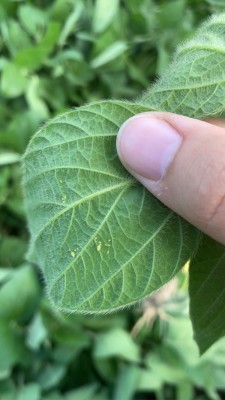Adding an Insecticide to your Soybean Herbicide Tank Mix
Katelyn Miller, Field Crops and Forage Specialist
Southwest New York Dairy, Livestock and Field Crops Program

I was recently asked; if you're going to apply herbicides to your soybeans and know that aphids are present, should you add an insecticide to the tank mix? Mike Stanyard, Field Crop Specialist with the Northwest NY Team says that there are 3 specific factors to keep in mind.
- 1. In-season stress
- 2. Natural enemy populations
- 3. Field history
In-season stressors like drought can help influence early-season spraying decisions. When aphids feed, they remove phloem from the plant which contains water. Various parts of the region have been getting rain, but dry conditions remain for many. Because water is already limited to the plant, spraying early on can help reduce plant stress.
Take note of natural enemy populations when scouting. Various insects, such as lady beetles, will help slow down populations by feeding on them. If you notice a high density of natural enemies, consider not adding insecticide to the mix. An application will kill all the unwanted insects, but also all the beneficials. If you know natural enemies are present, let them try to reduce populations naturally.
Field history can be a huge factor in making the decision to spray. Buckthorn is a woody shrub that is the overwintering host of soybean aphids. If it is present on your field edges, your field is at higher risk of infestation in season. Fields that are at high risk should consider using a pre-emergence herbicide to prevent aphid colonization. Aphids can be killed before laying eggs when there is an early frost. This can help to reduce populations for the following year. Remember that this past fall, it was mild, so be prepared for higher levels of aphid colonies in your fields this year.
These factors play into making the decision to add an insecticide to the tank mix, but It's also important to highlight scouting factors that will impact it as well. Let's review some scouting tidbits:
- Scout for aphids every week. Development is fastest when temperatures are between 70°F and mid 80°s. Under ideal conditions, there can be as many as 18 populations per year, making it important to scout frequently to keep ahead of populations.
- Ants will feed on the honeydew produced by aphids. If you see ants on plants, then you know there are aphids present.
- Remember to scout the young, fuzzy leaves on a plant. These leaves are the most susceptible to feeding. Typically, you will find them on the underside of the leaves, so make sure to check both sides of the leaf.
- The action threshold for aphids is 250 per plant. If 80% of the plants you pulled meet this threshold, then you should act. This threshold gives you approximately 7 days to treat the field before populations reach the economic threshold of 500 aphids per plant.
For more information on soybean aphids, visit https://extension.umn.edu/soybean-pest-management/scouting-soybean-aphid#whole-plant-counts-1353560.
Upcoming Events
WEBINAR - Automated Milking Systems Efficiency: Balancing Focus on Individual Cows and System Optimization
May 8, 2024
Please join Cornell the SWNY team and MSU Extension for our talk with Dr. Pablo Silva Boloña on improving efficiency of Automated milking systems by focusing on milking settings for individual and group success.
Broiler Field Day at Sunny Cove Farm
June 6, 2024
Alfred Station, NY
Join us for a field day to explore broiler production, processing, and finances. Meghan Snyder of Sunny Cove Farm will be our host. She raises small batches of organic broilers, processing them on-farm under the 1,000 bird exemption.
Stockmanship and Stewardship 2024
October 25, 2024
Hamburg, NY
Save the date!! The event is one of 4 across the US and is a two-day educational experience featuring low-stress cattle handling demonstrations, Beef Quality Assurance educational sessions, facility design sessions, and industry updates.
Announcements
No announcements at this time.





